Entrepreneurship and Small Business Management T/508/0495 Report
VerifiedAdded on 2021/07/28
|14
|4041
|75
Report
AI Summary
This report provides an overview of entrepreneurship and small business management, focusing on various types of entrepreneurial ventures, their characteristics, and their impact on the Nepalese economy. It discusses microenterprises, lifestyle firms, aggressive growth ventures, and medium-sized ventures, highlighting their differences and similarities. The report also analyzes the role of micro and small businesses in economic development, including their contribution to job creation and market competition. Furthermore, it explores the importance of small businesses in fostering the social economy and identifies key skills and traits of successful entrepreneurs. The document concludes by examining how personal background and experience can influence entrepreneurial success, and the role of organizations like RSTCA in supporting venture development.
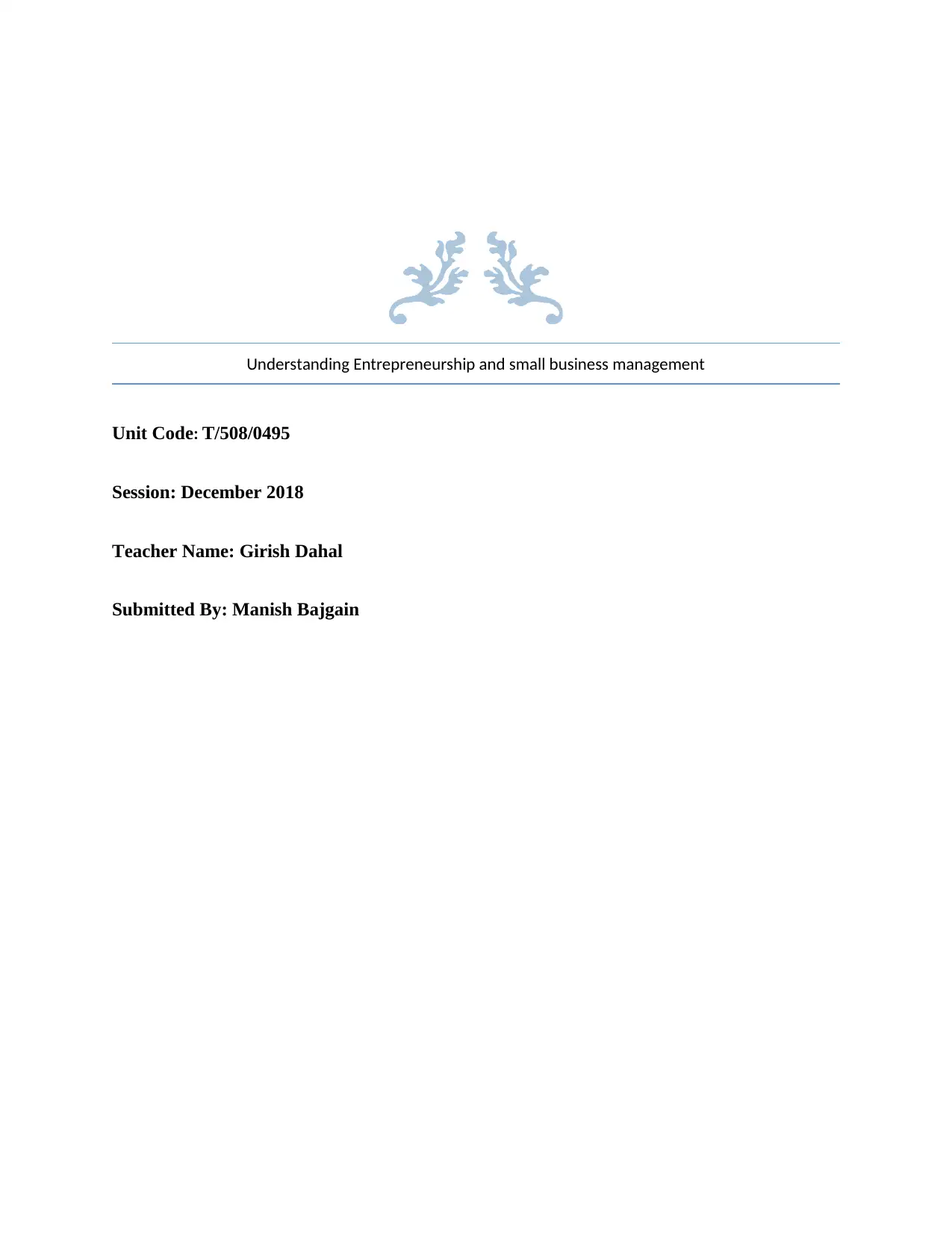
Understanding Entrepreneurship and small business management
Unit Code: T/508/0495
Session: December 2018
Teacher Name: Girish Dahal
Submitted By: Manish Bajgain
Unit Code: T/508/0495
Session: December 2018
Teacher Name: Girish Dahal
Submitted By: Manish Bajgain
Paraphrase This Document
Need a fresh take? Get an instant paraphrase of this document with our AI Paraphraser
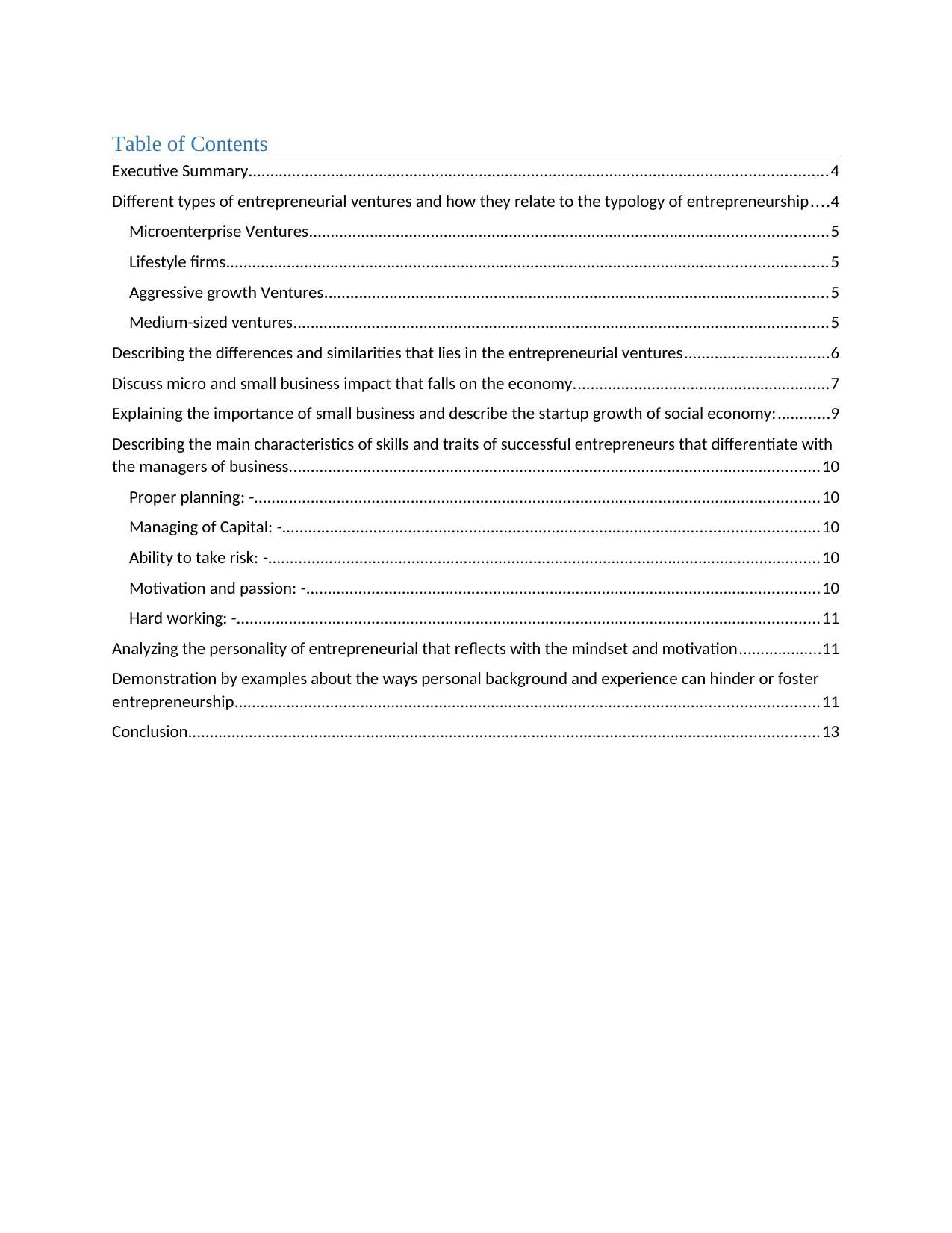
Table of Contents
Executive Summary.....................................................................................................................................4
Different types of entrepreneurial ventures and how they relate to the typology of entrepreneurship....4
Microenterprise Ventures.......................................................................................................................5
Lifestyle firms..........................................................................................................................................5
Aggressive growth Ventures....................................................................................................................5
Medium-sized ventures...........................................................................................................................5
Describing the differences and similarities that lies in the entrepreneurial ventures.................................6
Discuss micro and small business impact that falls on the economy...........................................................7
Explaining the importance of small business and describe the startup growth of social economy:............9
Describing the main characteristics of skills and traits of successful entrepreneurs that differentiate with
the managers of business..........................................................................................................................10
Proper planning: -..................................................................................................................................10
Managing of Capital: -...........................................................................................................................10
Ability to take risk: -...............................................................................................................................10
Motivation and passion: -......................................................................................................................10
Hard working: -......................................................................................................................................11
Analyzing the personality of entrepreneurial that reflects with the mindset and motivation...................11
Demonstration by examples about the ways personal background and experience can hinder or foster
entrepreneurship......................................................................................................................................11
Conclusion.................................................................................................................................................13
Executive Summary.....................................................................................................................................4
Different types of entrepreneurial ventures and how they relate to the typology of entrepreneurship....4
Microenterprise Ventures.......................................................................................................................5
Lifestyle firms..........................................................................................................................................5
Aggressive growth Ventures....................................................................................................................5
Medium-sized ventures...........................................................................................................................5
Describing the differences and similarities that lies in the entrepreneurial ventures.................................6
Discuss micro and small business impact that falls on the economy...........................................................7
Explaining the importance of small business and describe the startup growth of social economy:............9
Describing the main characteristics of skills and traits of successful entrepreneurs that differentiate with
the managers of business..........................................................................................................................10
Proper planning: -..................................................................................................................................10
Managing of Capital: -...........................................................................................................................10
Ability to take risk: -...............................................................................................................................10
Motivation and passion: -......................................................................................................................10
Hard working: -......................................................................................................................................11
Analyzing the personality of entrepreneurial that reflects with the mindset and motivation...................11
Demonstration by examples about the ways personal background and experience can hinder or foster
entrepreneurship......................................................................................................................................11
Conclusion.................................................................................................................................................13
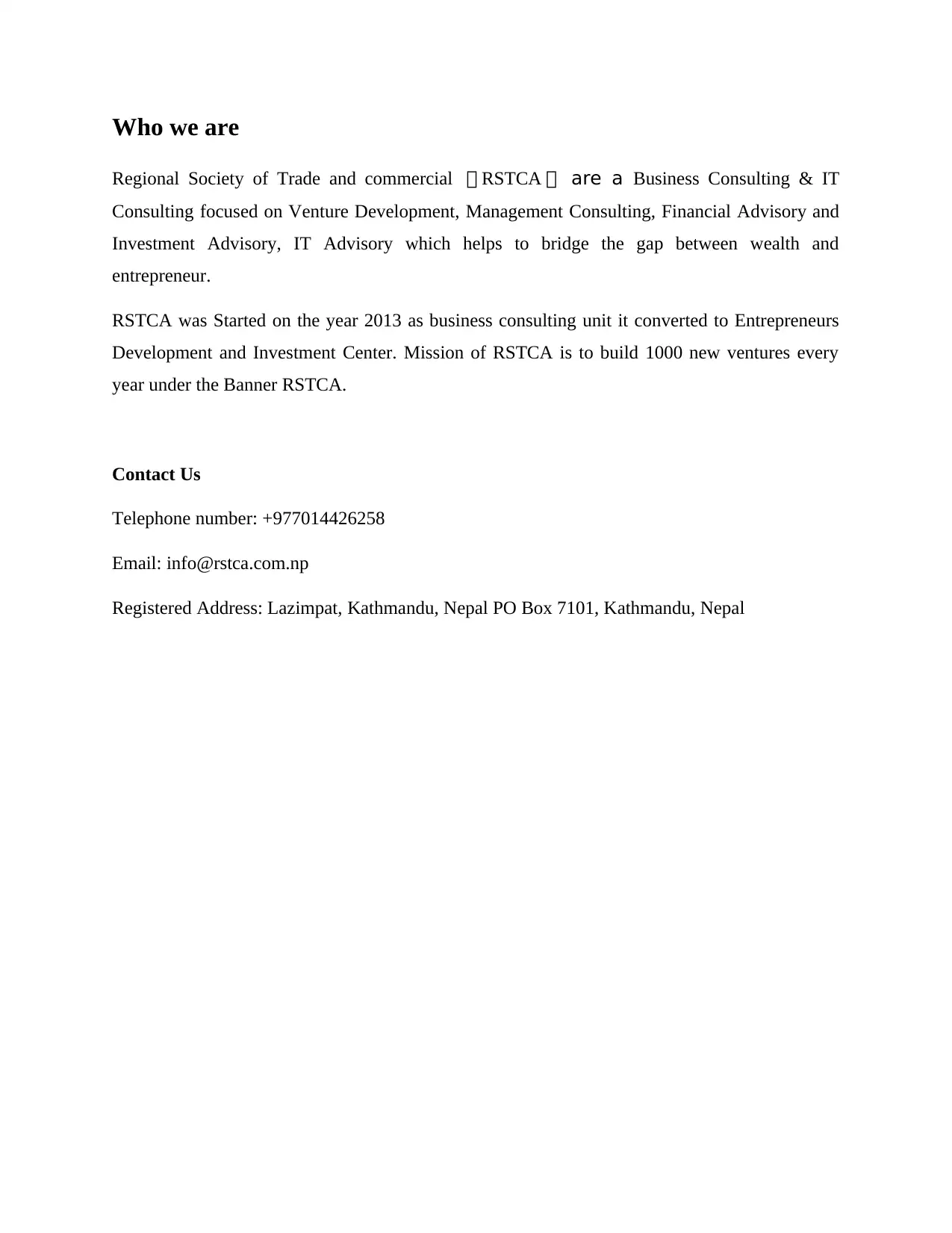
Who we are
Regional Society of Trade and commercial ( RSTCA ( are a Business Consulting & IT
Consulting focused on Venture Development, Management Consulting, Financial Advisory and
Investment Advisory, IT Advisory which helps to bridge the gap between wealth and
entrepreneur.
RSTCA was Started on the year 2013 as business consulting unit it converted to Entrepreneurs
Development and Investment Center. Mission of RSTCA is to build 1000 new ventures every
year under the Banner RSTCA.
Contact Us
Telephone number: +977014426258
Email: info@rstca.com.np
Registered Address: Lazimpat, Kathmandu, Nepal PO Box 7101, Kathmandu, Nepal
Regional Society of Trade and commercial ( RSTCA ( are a Business Consulting & IT
Consulting focused on Venture Development, Management Consulting, Financial Advisory and
Investment Advisory, IT Advisory which helps to bridge the gap between wealth and
entrepreneur.
RSTCA was Started on the year 2013 as business consulting unit it converted to Entrepreneurs
Development and Investment Center. Mission of RSTCA is to build 1000 new ventures every
year under the Banner RSTCA.
Contact Us
Telephone number: +977014426258
Email: info@rstca.com.np
Registered Address: Lazimpat, Kathmandu, Nepal PO Box 7101, Kathmandu, Nepal
⊘ This is a preview!⊘
Do you want full access?
Subscribe today to unlock all pages.

Trusted by 1+ million students worldwide
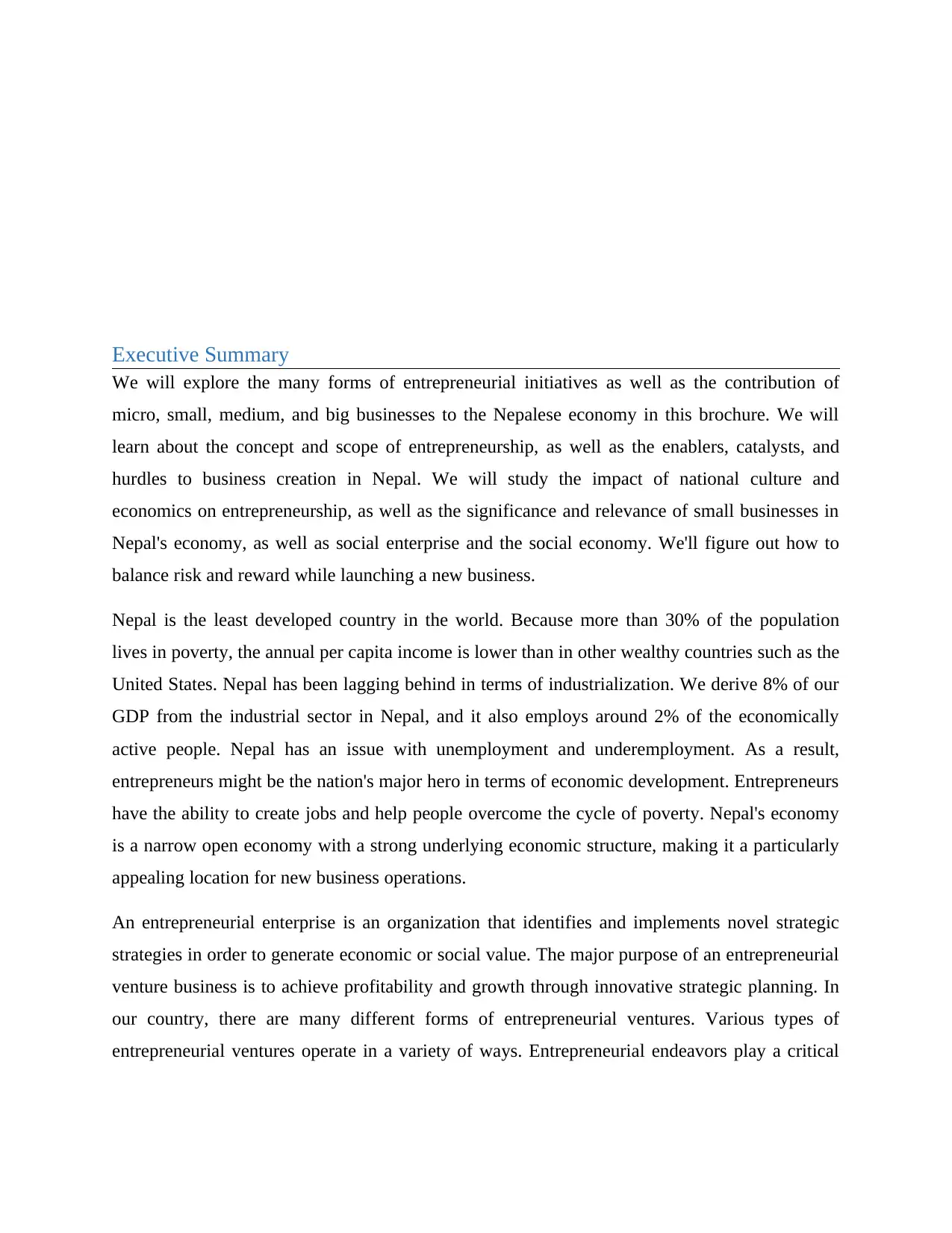
Executive Summary
We will explore the many forms of entrepreneurial initiatives as well as the contribution of
micro, small, medium, and big businesses to the Nepalese economy in this brochure. We will
learn about the concept and scope of entrepreneurship, as well as the enablers, catalysts, and
hurdles to business creation in Nepal. We will study the impact of national culture and
economics on entrepreneurship, as well as the significance and relevance of small businesses in
Nepal's economy, as well as social enterprise and the social economy. We'll figure out how to
balance risk and reward while launching a new business.
Nepal is the least developed country in the world. Because more than 30% of the population
lives in poverty, the annual per capita income is lower than in other wealthy countries such as the
United States. Nepal has been lagging behind in terms of industrialization. We derive 8% of our
GDP from the industrial sector in Nepal, and it also employs around 2% of the economically
active people. Nepal has an issue with unemployment and underemployment. As a result,
entrepreneurs might be the nation's major hero in terms of economic development. Entrepreneurs
have the ability to create jobs and help people overcome the cycle of poverty. Nepal's economy
is a narrow open economy with a strong underlying economic structure, making it a particularly
appealing location for new business operations.
An entrepreneurial enterprise is an organization that identifies and implements novel strategic
strategies in order to generate economic or social value. The major purpose of an entrepreneurial
venture business is to achieve profitability and growth through innovative strategic planning. In
our country, there are many different forms of entrepreneurial ventures. Various types of
entrepreneurial ventures operate in a variety of ways. Entrepreneurial endeavors play a critical
We will explore the many forms of entrepreneurial initiatives as well as the contribution of
micro, small, medium, and big businesses to the Nepalese economy in this brochure. We will
learn about the concept and scope of entrepreneurship, as well as the enablers, catalysts, and
hurdles to business creation in Nepal. We will study the impact of national culture and
economics on entrepreneurship, as well as the significance and relevance of small businesses in
Nepal's economy, as well as social enterprise and the social economy. We'll figure out how to
balance risk and reward while launching a new business.
Nepal is the least developed country in the world. Because more than 30% of the population
lives in poverty, the annual per capita income is lower than in other wealthy countries such as the
United States. Nepal has been lagging behind in terms of industrialization. We derive 8% of our
GDP from the industrial sector in Nepal, and it also employs around 2% of the economically
active people. Nepal has an issue with unemployment and underemployment. As a result,
entrepreneurs might be the nation's major hero in terms of economic development. Entrepreneurs
have the ability to create jobs and help people overcome the cycle of poverty. Nepal's economy
is a narrow open economy with a strong underlying economic structure, making it a particularly
appealing location for new business operations.
An entrepreneurial enterprise is an organization that identifies and implements novel strategic
strategies in order to generate economic or social value. The major purpose of an entrepreneurial
venture business is to achieve profitability and growth through innovative strategic planning. In
our country, there are many different forms of entrepreneurial ventures. Various types of
entrepreneurial ventures operate in a variety of ways. Entrepreneurial endeavors play a critical
Paraphrase This Document
Need a fresh take? Get an instant paraphrase of this document with our AI Paraphraser
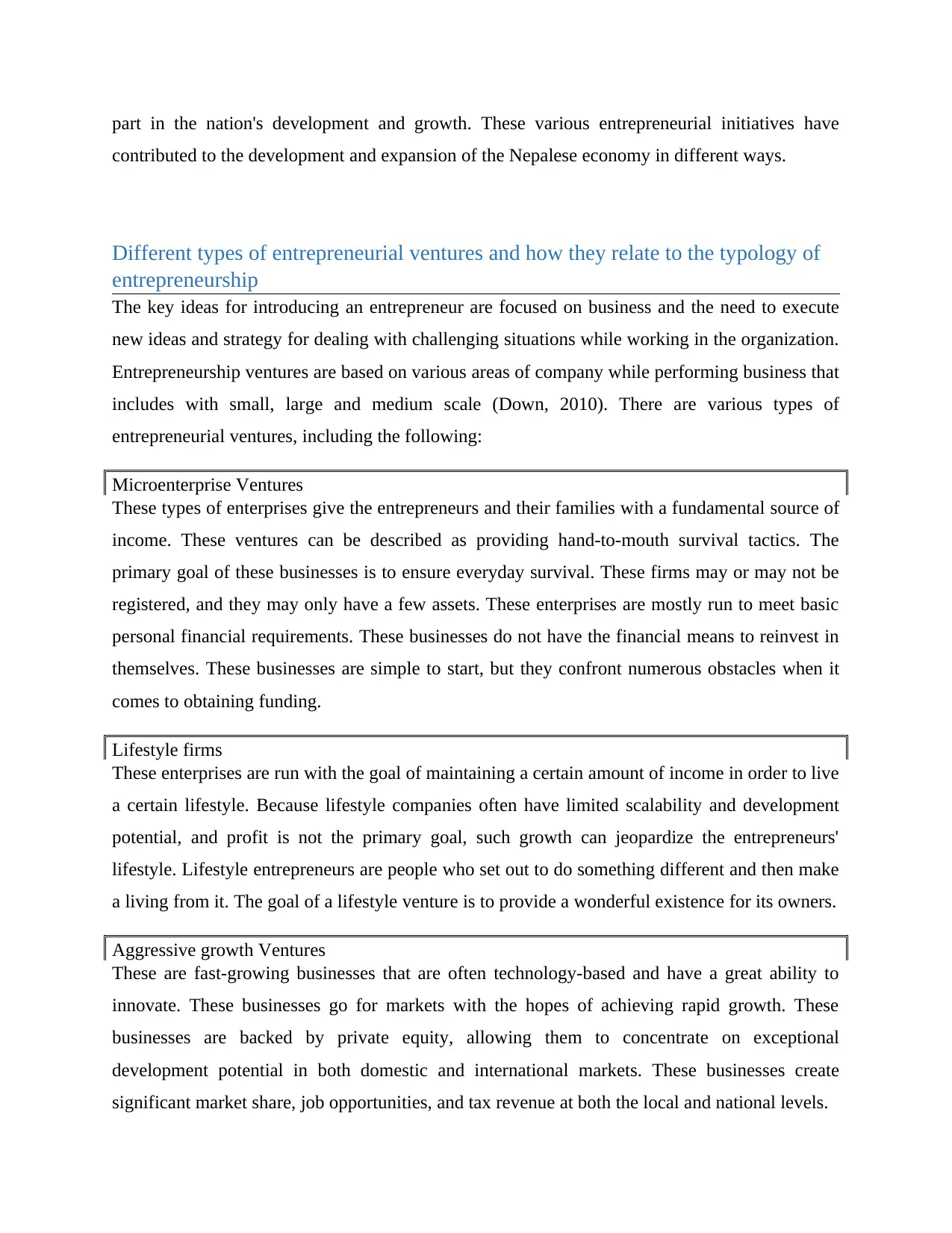
part in the nation's development and growth. These various entrepreneurial initiatives have
contributed to the development and expansion of the Nepalese economy in different ways.
Different types of entrepreneurial ventures and how they relate to the typology of
entrepreneurship
The key ideas for introducing an entrepreneur are focused on business and the need to execute
new ideas and strategy for dealing with challenging situations while working in the organization.
Entrepreneurship ventures are based on various areas of company while performing business that
includes with small, large and medium scale (Down, 2010). There are various types of
entrepreneurial ventures, including the following:
Microenterprise Ventures
These types of enterprises give the entrepreneurs and their families with a fundamental source of
income. These ventures can be described as providing hand-to-mouth survival tactics. The
primary goal of these businesses is to ensure everyday survival. These firms may or may not be
registered, and they may only have a few assets. These enterprises are mostly run to meet basic
personal financial requirements. These businesses do not have the financial means to reinvest in
themselves. These businesses are simple to start, but they confront numerous obstacles when it
comes to obtaining funding.
Lifestyle firms
These enterprises are run with the goal of maintaining a certain amount of income in order to live
a certain lifestyle. Because lifestyle companies often have limited scalability and development
potential, and profit is not the primary goal, such growth can jeopardize the entrepreneurs'
lifestyle. Lifestyle entrepreneurs are people who set out to do something different and then make
a living from it. The goal of a lifestyle venture is to provide a wonderful existence for its owners.
Aggressive growth Ventures
These are fast-growing businesses that are often technology-based and have a great ability to
innovate. These businesses go for markets with the hopes of achieving rapid growth. These
businesses are backed by private equity, allowing them to concentrate on exceptional
development potential in both domestic and international markets. These businesses create
significant market share, job opportunities, and tax revenue at both the local and national levels.
contributed to the development and expansion of the Nepalese economy in different ways.
Different types of entrepreneurial ventures and how they relate to the typology of
entrepreneurship
The key ideas for introducing an entrepreneur are focused on business and the need to execute
new ideas and strategy for dealing with challenging situations while working in the organization.
Entrepreneurship ventures are based on various areas of company while performing business that
includes with small, large and medium scale (Down, 2010). There are various types of
entrepreneurial ventures, including the following:
Microenterprise Ventures
These types of enterprises give the entrepreneurs and their families with a fundamental source of
income. These ventures can be described as providing hand-to-mouth survival tactics. The
primary goal of these businesses is to ensure everyday survival. These firms may or may not be
registered, and they may only have a few assets. These enterprises are mostly run to meet basic
personal financial requirements. These businesses do not have the financial means to reinvest in
themselves. These businesses are simple to start, but they confront numerous obstacles when it
comes to obtaining funding.
Lifestyle firms
These enterprises are run with the goal of maintaining a certain amount of income in order to live
a certain lifestyle. Because lifestyle companies often have limited scalability and development
potential, and profit is not the primary goal, such growth can jeopardize the entrepreneurs'
lifestyle. Lifestyle entrepreneurs are people who set out to do something different and then make
a living from it. The goal of a lifestyle venture is to provide a wonderful existence for its owners.
Aggressive growth Ventures
These are fast-growing businesses that are often technology-based and have a great ability to
innovate. These businesses go for markets with the hopes of achieving rapid growth. These
businesses are backed by private equity, allowing them to concentrate on exceptional
development potential in both domestic and international markets. These businesses create
significant market share, job opportunities, and tax revenue at both the local and national levels.
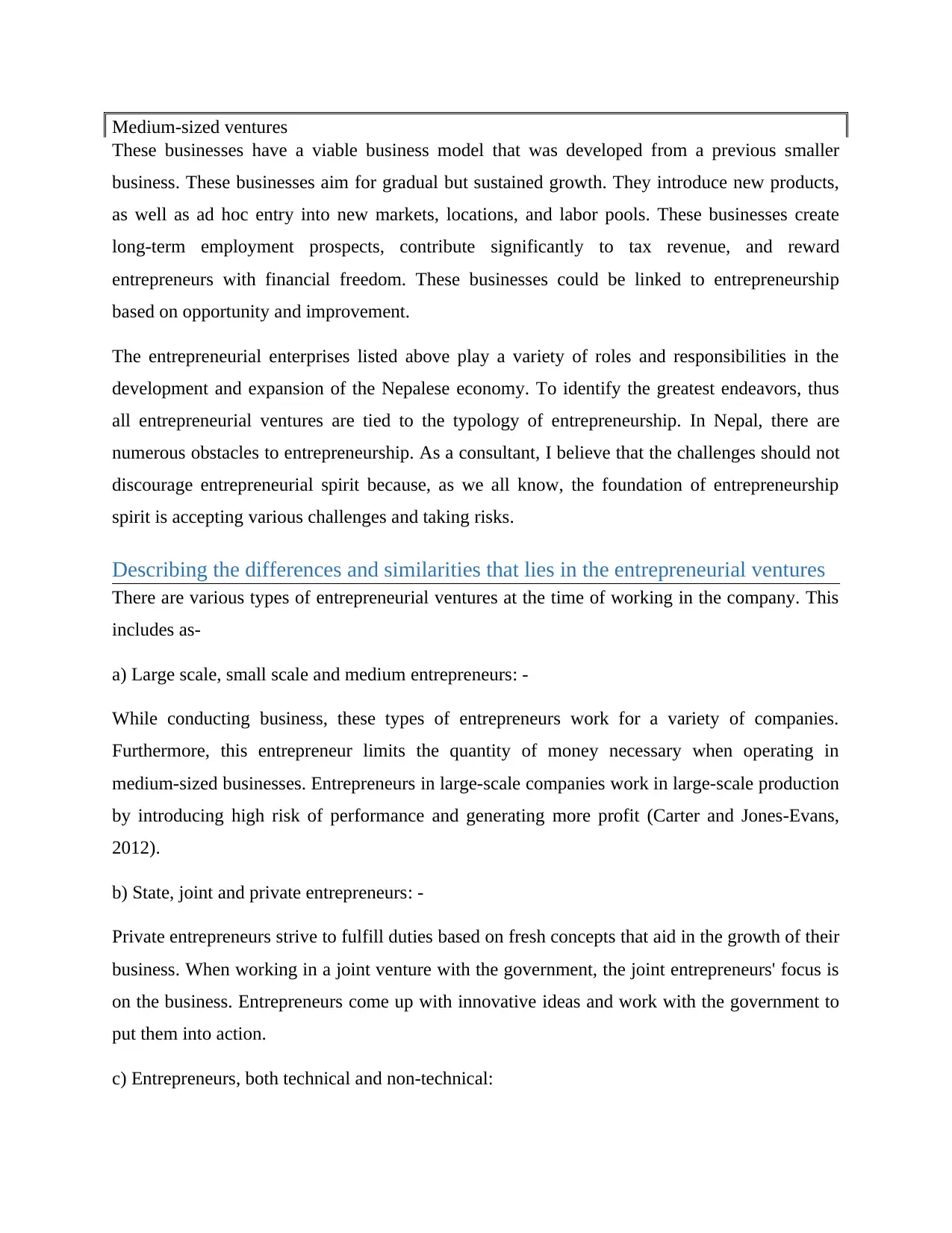
Medium-sized ventures
These businesses have a viable business model that was developed from a previous smaller
business. These businesses aim for gradual but sustained growth. They introduce new products,
as well as ad hoc entry into new markets, locations, and labor pools. These businesses create
long-term employment prospects, contribute significantly to tax revenue, and reward
entrepreneurs with financial freedom. These businesses could be linked to entrepreneurship
based on opportunity and improvement.
The entrepreneurial enterprises listed above play a variety of roles and responsibilities in the
development and expansion of the Nepalese economy. To identify the greatest endeavors, thus
all entrepreneurial ventures are tied to the typology of entrepreneurship. In Nepal, there are
numerous obstacles to entrepreneurship. As a consultant, I believe that the challenges should not
discourage entrepreneurial spirit because, as we all know, the foundation of entrepreneurship
spirit is accepting various challenges and taking risks.
Describing the differences and similarities that lies in the entrepreneurial ventures
There are various types of entrepreneurial ventures at the time of working in the company. This
includes as-
a) Large scale, small scale and medium entrepreneurs: -
While conducting business, these types of entrepreneurs work for a variety of companies.
Furthermore, this entrepreneur limits the quantity of money necessary when operating in
medium-sized businesses. Entrepreneurs in large-scale companies work in large-scale production
by introducing high risk of performance and generating more profit (Carter and Jones-Evans,
2012).
b) State, joint and private entrepreneurs: -
Private entrepreneurs strive to fulfill duties based on fresh concepts that aid in the growth of their
business. When working in a joint venture with the government, the joint entrepreneurs' focus is
on the business. Entrepreneurs come up with innovative ideas and work with the government to
put them into action.
c) Entrepreneurs, both technical and non-technical:
These businesses have a viable business model that was developed from a previous smaller
business. These businesses aim for gradual but sustained growth. They introduce new products,
as well as ad hoc entry into new markets, locations, and labor pools. These businesses create
long-term employment prospects, contribute significantly to tax revenue, and reward
entrepreneurs with financial freedom. These businesses could be linked to entrepreneurship
based on opportunity and improvement.
The entrepreneurial enterprises listed above play a variety of roles and responsibilities in the
development and expansion of the Nepalese economy. To identify the greatest endeavors, thus
all entrepreneurial ventures are tied to the typology of entrepreneurship. In Nepal, there are
numerous obstacles to entrepreneurship. As a consultant, I believe that the challenges should not
discourage entrepreneurial spirit because, as we all know, the foundation of entrepreneurship
spirit is accepting various challenges and taking risks.
Describing the differences and similarities that lies in the entrepreneurial ventures
There are various types of entrepreneurial ventures at the time of working in the company. This
includes as-
a) Large scale, small scale and medium entrepreneurs: -
While conducting business, these types of entrepreneurs work for a variety of companies.
Furthermore, this entrepreneur limits the quantity of money necessary when operating in
medium-sized businesses. Entrepreneurs in large-scale companies work in large-scale production
by introducing high risk of performance and generating more profit (Carter and Jones-Evans,
2012).
b) State, joint and private entrepreneurs: -
Private entrepreneurs strive to fulfill duties based on fresh concepts that aid in the growth of their
business. When working in a joint venture with the government, the joint entrepreneurs' focus is
on the business. Entrepreneurs come up with innovative ideas and work with the government to
put them into action.
c) Entrepreneurs, both technical and non-technical:
⊘ This is a preview!⊘
Do you want full access?
Subscribe today to unlock all pages.

Trusted by 1+ million students worldwide
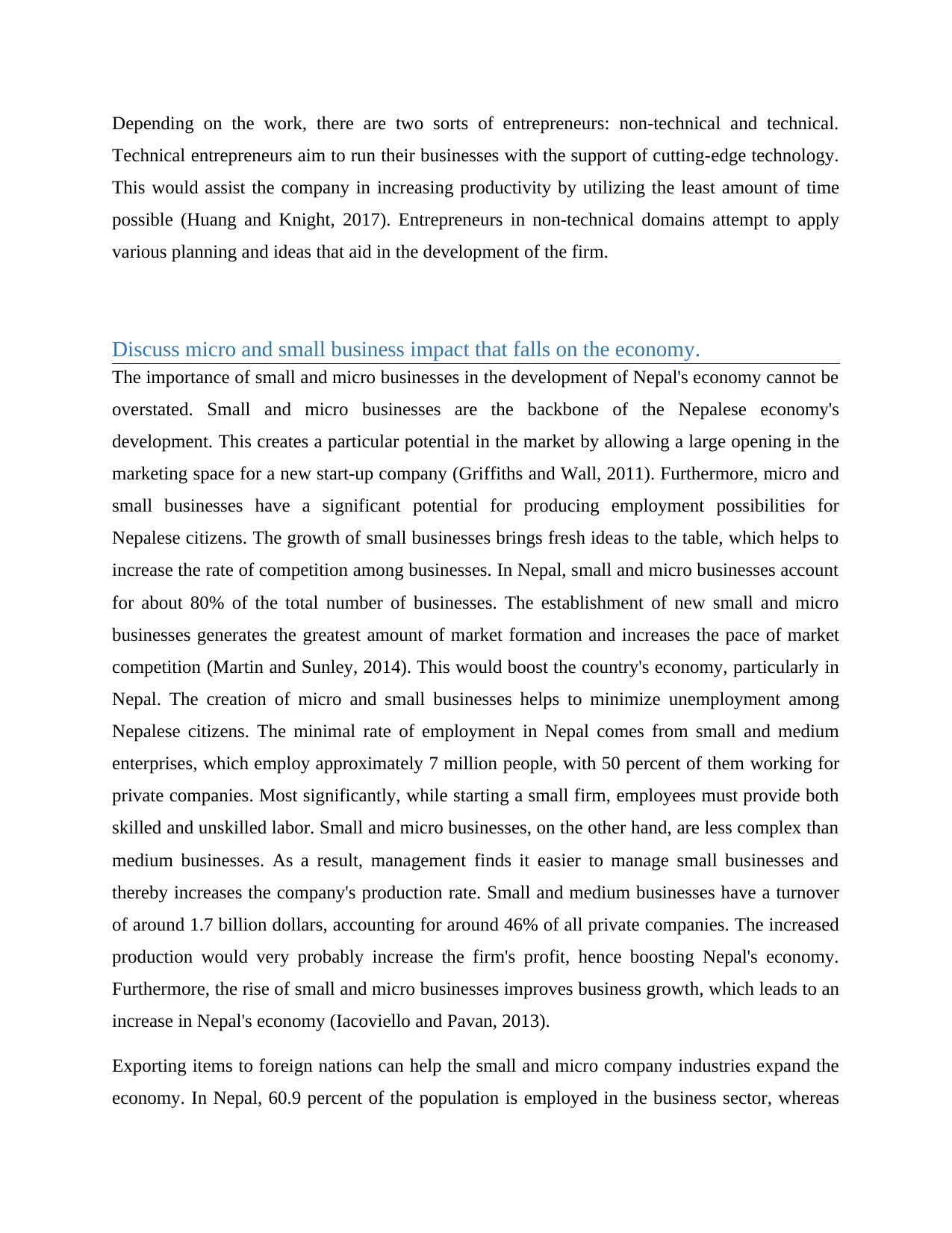
Depending on the work, there are two sorts of entrepreneurs: non-technical and technical.
Technical entrepreneurs aim to run their businesses with the support of cutting-edge technology.
This would assist the company in increasing productivity by utilizing the least amount of time
possible (Huang and Knight, 2017). Entrepreneurs in non-technical domains attempt to apply
various planning and ideas that aid in the development of the firm.
Discuss micro and small business impact that falls on the economy.
The importance of small and micro businesses in the development of Nepal's economy cannot be
overstated. Small and micro businesses are the backbone of the Nepalese economy's
development. This creates a particular potential in the market by allowing a large opening in the
marketing space for a new start-up company (Griffiths and Wall, 2011). Furthermore, micro and
small businesses have a significant potential for producing employment possibilities for
Nepalese citizens. The growth of small businesses brings fresh ideas to the table, which helps to
increase the rate of competition among businesses. In Nepal, small and micro businesses account
for about 80% of the total number of businesses. The establishment of new small and micro
businesses generates the greatest amount of market formation and increases the pace of market
competition (Martin and Sunley, 2014). This would boost the country's economy, particularly in
Nepal. The creation of micro and small businesses helps to minimize unemployment among
Nepalese citizens. The minimal rate of employment in Nepal comes from small and medium
enterprises, which employ approximately 7 million people, with 50 percent of them working for
private companies. Most significantly, while starting a small firm, employees must provide both
skilled and unskilled labor. Small and micro businesses, on the other hand, are less complex than
medium businesses. As a result, management finds it easier to manage small businesses and
thereby increases the company's production rate. Small and medium businesses have a turnover
of around 1.7 billion dollars, accounting for around 46% of all private companies. The increased
production would very probably increase the firm's profit, hence boosting Nepal's economy.
Furthermore, the rise of small and micro businesses improves business growth, which leads to an
increase in Nepal's economy (Iacoviello and Pavan, 2013).
Exporting items to foreign nations can help the small and micro company industries expand the
economy. In Nepal, 60.9 percent of the population is employed in the business sector, whereas
Technical entrepreneurs aim to run their businesses with the support of cutting-edge technology.
This would assist the company in increasing productivity by utilizing the least amount of time
possible (Huang and Knight, 2017). Entrepreneurs in non-technical domains attempt to apply
various planning and ideas that aid in the development of the firm.
Discuss micro and small business impact that falls on the economy.
The importance of small and micro businesses in the development of Nepal's economy cannot be
overstated. Small and micro businesses are the backbone of the Nepalese economy's
development. This creates a particular potential in the market by allowing a large opening in the
marketing space for a new start-up company (Griffiths and Wall, 2011). Furthermore, micro and
small businesses have a significant potential for producing employment possibilities for
Nepalese citizens. The growth of small businesses brings fresh ideas to the table, which helps to
increase the rate of competition among businesses. In Nepal, small and micro businesses account
for about 80% of the total number of businesses. The establishment of new small and micro
businesses generates the greatest amount of market formation and increases the pace of market
competition (Martin and Sunley, 2014). This would boost the country's economy, particularly in
Nepal. The creation of micro and small businesses helps to minimize unemployment among
Nepalese citizens. The minimal rate of employment in Nepal comes from small and medium
enterprises, which employ approximately 7 million people, with 50 percent of them working for
private companies. Most significantly, while starting a small firm, employees must provide both
skilled and unskilled labor. Small and micro businesses, on the other hand, are less complex than
medium businesses. As a result, management finds it easier to manage small businesses and
thereby increases the company's production rate. Small and medium businesses have a turnover
of around 1.7 billion dollars, accounting for around 46% of all private companies. The increased
production would very probably increase the firm's profit, hence boosting Nepal's economy.
Furthermore, the rise of small and micro businesses improves business growth, which leads to an
increase in Nepal's economy (Iacoviello and Pavan, 2013).
Exporting items to foreign nations can help the small and micro company industries expand the
economy. In Nepal, 60.9 percent of the population is employed in the business sector, whereas
Paraphrase This Document
Need a fresh take? Get an instant paraphrase of this document with our AI Paraphraser
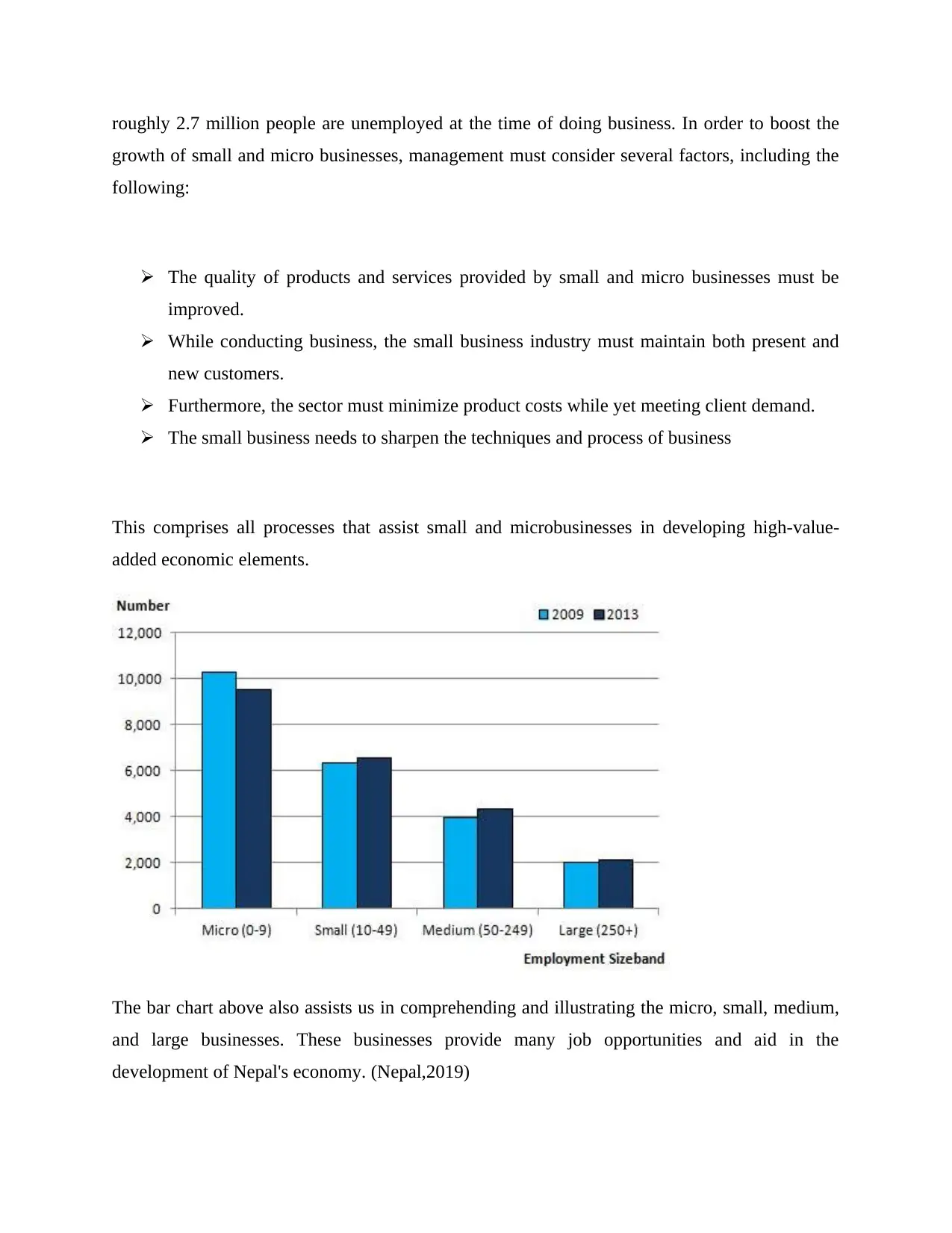
roughly 2.7 million people are unemployed at the time of doing business. In order to boost the
growth of small and micro businesses, management must consider several factors, including the
following:
The quality of products and services provided by small and micro businesses must be
improved.
While conducting business, the small business industry must maintain both present and
new customers.
Furthermore, the sector must minimize product costs while yet meeting client demand.
The small business needs to sharpen the techniques and process of business
This comprises all processes that assist small and microbusinesses in developing high-value-
added economic elements.
The bar chart above also assists us in comprehending and illustrating the micro, small, medium,
and large businesses. These businesses provide many job opportunities and aid in the
development of Nepal's economy. (Nepal,2019)
growth of small and micro businesses, management must consider several factors, including the
following:
The quality of products and services provided by small and micro businesses must be
improved.
While conducting business, the small business industry must maintain both present and
new customers.
Furthermore, the sector must minimize product costs while yet meeting client demand.
The small business needs to sharpen the techniques and process of business
This comprises all processes that assist small and microbusinesses in developing high-value-
added economic elements.
The bar chart above also assists us in comprehending and illustrating the micro, small, medium,
and large businesses. These businesses provide many job opportunities and aid in the
development of Nepal's economy. (Nepal,2019)
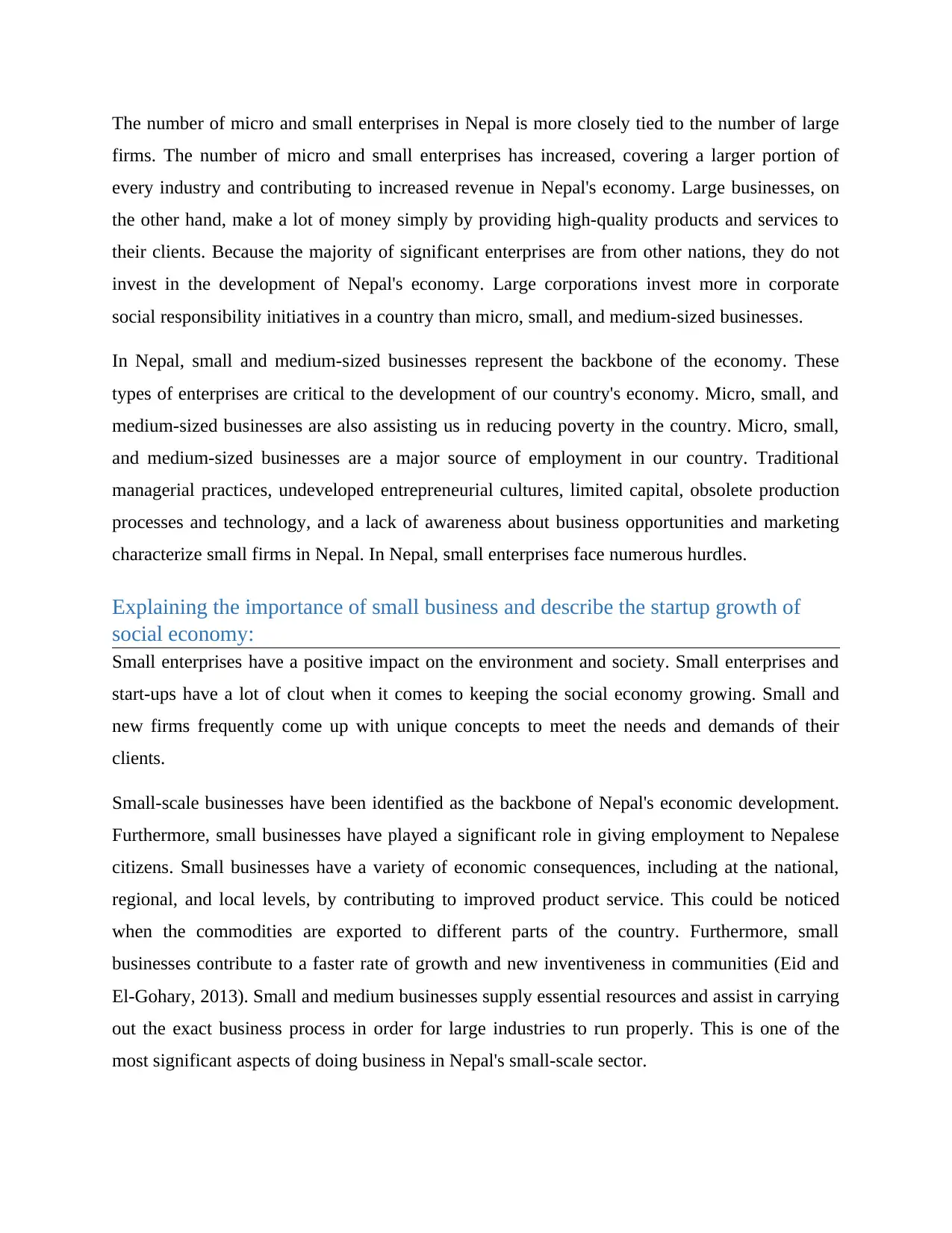
The number of micro and small enterprises in Nepal is more closely tied to the number of large
firms. The number of micro and small enterprises has increased, covering a larger portion of
every industry and contributing to increased revenue in Nepal's economy. Large businesses, on
the other hand, make a lot of money simply by providing high-quality products and services to
their clients. Because the majority of significant enterprises are from other nations, they do not
invest in the development of Nepal's economy. Large corporations invest more in corporate
social responsibility initiatives in a country than micro, small, and medium-sized businesses.
In Nepal, small and medium-sized businesses represent the backbone of the economy. These
types of enterprises are critical to the development of our country's economy. Micro, small, and
medium-sized businesses are also assisting us in reducing poverty in the country. Micro, small,
and medium-sized businesses are a major source of employment in our country. Traditional
managerial practices, undeveloped entrepreneurial cultures, limited capital, obsolete production
processes and technology, and a lack of awareness about business opportunities and marketing
characterize small firms in Nepal. In Nepal, small enterprises face numerous hurdles.
Explaining the importance of small business and describe the startup growth of
social economy:
Small enterprises have a positive impact on the environment and society. Small enterprises and
start-ups have a lot of clout when it comes to keeping the social economy growing. Small and
new firms frequently come up with unique concepts to meet the needs and demands of their
clients.
Small-scale businesses have been identified as the backbone of Nepal's economic development.
Furthermore, small businesses have played a significant role in giving employment to Nepalese
citizens. Small businesses have a variety of economic consequences, including at the national,
regional, and local levels, by contributing to improved product service. This could be noticed
when the commodities are exported to different parts of the country. Furthermore, small
businesses contribute to a faster rate of growth and new inventiveness in communities (Eid and
El-Gohary, 2013). Small and medium businesses supply essential resources and assist in carrying
out the exact business process in order for large industries to run properly. This is one of the
most significant aspects of doing business in Nepal's small-scale sector.
firms. The number of micro and small enterprises has increased, covering a larger portion of
every industry and contributing to increased revenue in Nepal's economy. Large businesses, on
the other hand, make a lot of money simply by providing high-quality products and services to
their clients. Because the majority of significant enterprises are from other nations, they do not
invest in the development of Nepal's economy. Large corporations invest more in corporate
social responsibility initiatives in a country than micro, small, and medium-sized businesses.
In Nepal, small and medium-sized businesses represent the backbone of the economy. These
types of enterprises are critical to the development of our country's economy. Micro, small, and
medium-sized businesses are also assisting us in reducing poverty in the country. Micro, small,
and medium-sized businesses are a major source of employment in our country. Traditional
managerial practices, undeveloped entrepreneurial cultures, limited capital, obsolete production
processes and technology, and a lack of awareness about business opportunities and marketing
characterize small firms in Nepal. In Nepal, small enterprises face numerous hurdles.
Explaining the importance of small business and describe the startup growth of
social economy:
Small enterprises have a positive impact on the environment and society. Small enterprises and
start-ups have a lot of clout when it comes to keeping the social economy growing. Small and
new firms frequently come up with unique concepts to meet the needs and demands of their
clients.
Small-scale businesses have been identified as the backbone of Nepal's economic development.
Furthermore, small businesses have played a significant role in giving employment to Nepalese
citizens. Small businesses have a variety of economic consequences, including at the national,
regional, and local levels, by contributing to improved product service. This could be noticed
when the commodities are exported to different parts of the country. Furthermore, small
businesses contribute to a faster rate of growth and new inventiveness in communities (Eid and
El-Gohary, 2013). Small and medium businesses supply essential resources and assist in carrying
out the exact business process in order for large industries to run properly. This is one of the
most significant aspects of doing business in Nepal's small-scale sector.
⊘ This is a preview!⊘
Do you want full access?
Subscribe today to unlock all pages.

Trusted by 1+ million students worldwide
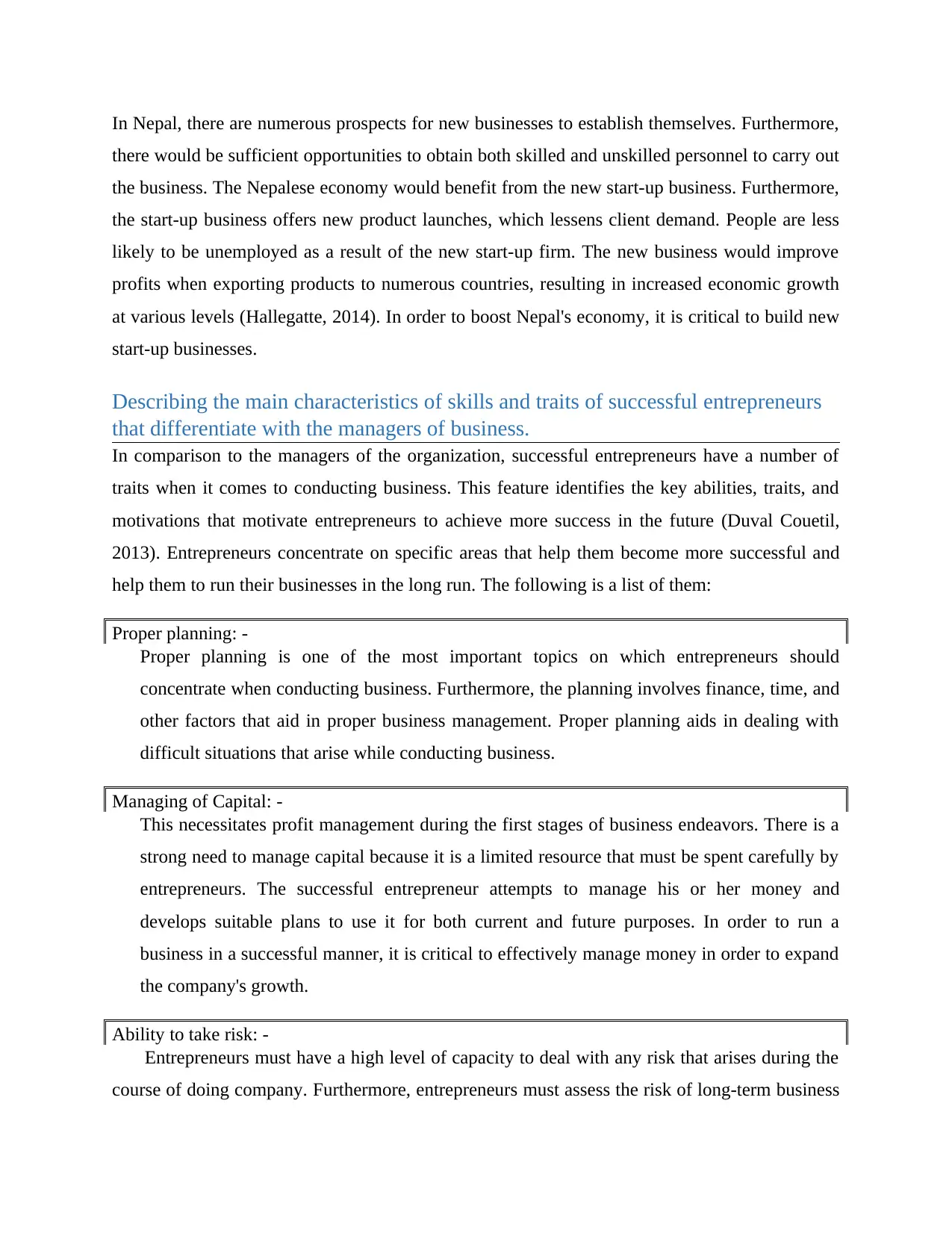
In Nepal, there are numerous prospects for new businesses to establish themselves. Furthermore,
there would be sufficient opportunities to obtain both skilled and unskilled personnel to carry out
the business. The Nepalese economy would benefit from the new start-up business. Furthermore,
the start-up business offers new product launches, which lessens client demand. People are less
likely to be unemployed as a result of the new start-up firm. The new business would improve
profits when exporting products to numerous countries, resulting in increased economic growth
at various levels (Hallegatte, 2014). In order to boost Nepal's economy, it is critical to build new
start-up businesses.
Describing the main characteristics of skills and traits of successful entrepreneurs
that differentiate with the managers of business.
In comparison to the managers of the organization, successful entrepreneurs have a number of
traits when it comes to conducting business. This feature identifies the key abilities, traits, and
motivations that motivate entrepreneurs to achieve more success in the future (Duval Couetil,
2013). Entrepreneurs concentrate on specific areas that help them become more successful and
help them to run their businesses in the long run. The following is a list of them:
Proper planning: -
Proper planning is one of the most important topics on which entrepreneurs should
concentrate when conducting business. Furthermore, the planning involves finance, time, and
other factors that aid in proper business management. Proper planning aids in dealing with
difficult situations that arise while conducting business.
Managing of Capital: -
This necessitates profit management during the first stages of business endeavors. There is a
strong need to manage capital because it is a limited resource that must be spent carefully by
entrepreneurs. The successful entrepreneur attempts to manage his or her money and
develops suitable plans to use it for both current and future purposes. In order to run a
business in a successful manner, it is critical to effectively manage money in order to expand
the company's growth.
Ability to take risk: -
Entrepreneurs must have a high level of capacity to deal with any risk that arises during the
course of doing company. Furthermore, entrepreneurs must assess the risk of long-term business
there would be sufficient opportunities to obtain both skilled and unskilled personnel to carry out
the business. The Nepalese economy would benefit from the new start-up business. Furthermore,
the start-up business offers new product launches, which lessens client demand. People are less
likely to be unemployed as a result of the new start-up firm. The new business would improve
profits when exporting products to numerous countries, resulting in increased economic growth
at various levels (Hallegatte, 2014). In order to boost Nepal's economy, it is critical to build new
start-up businesses.
Describing the main characteristics of skills and traits of successful entrepreneurs
that differentiate with the managers of business.
In comparison to the managers of the organization, successful entrepreneurs have a number of
traits when it comes to conducting business. This feature identifies the key abilities, traits, and
motivations that motivate entrepreneurs to achieve more success in the future (Duval Couetil,
2013). Entrepreneurs concentrate on specific areas that help them become more successful and
help them to run their businesses in the long run. The following is a list of them:
Proper planning: -
Proper planning is one of the most important topics on which entrepreneurs should
concentrate when conducting business. Furthermore, the planning involves finance, time, and
other factors that aid in proper business management. Proper planning aids in dealing with
difficult situations that arise while conducting business.
Managing of Capital: -
This necessitates profit management during the first stages of business endeavors. There is a
strong need to manage capital because it is a limited resource that must be spent carefully by
entrepreneurs. The successful entrepreneur attempts to manage his or her money and
develops suitable plans to use it for both current and future purposes. In order to run a
business in a successful manner, it is critical to effectively manage money in order to expand
the company's growth.
Ability to take risk: -
Entrepreneurs must have a high level of capacity to deal with any risk that arises during the
course of doing company. Furthermore, entrepreneurs must assess the risk of long-term business
Paraphrase This Document
Need a fresh take? Get an instant paraphrase of this document with our AI Paraphraser
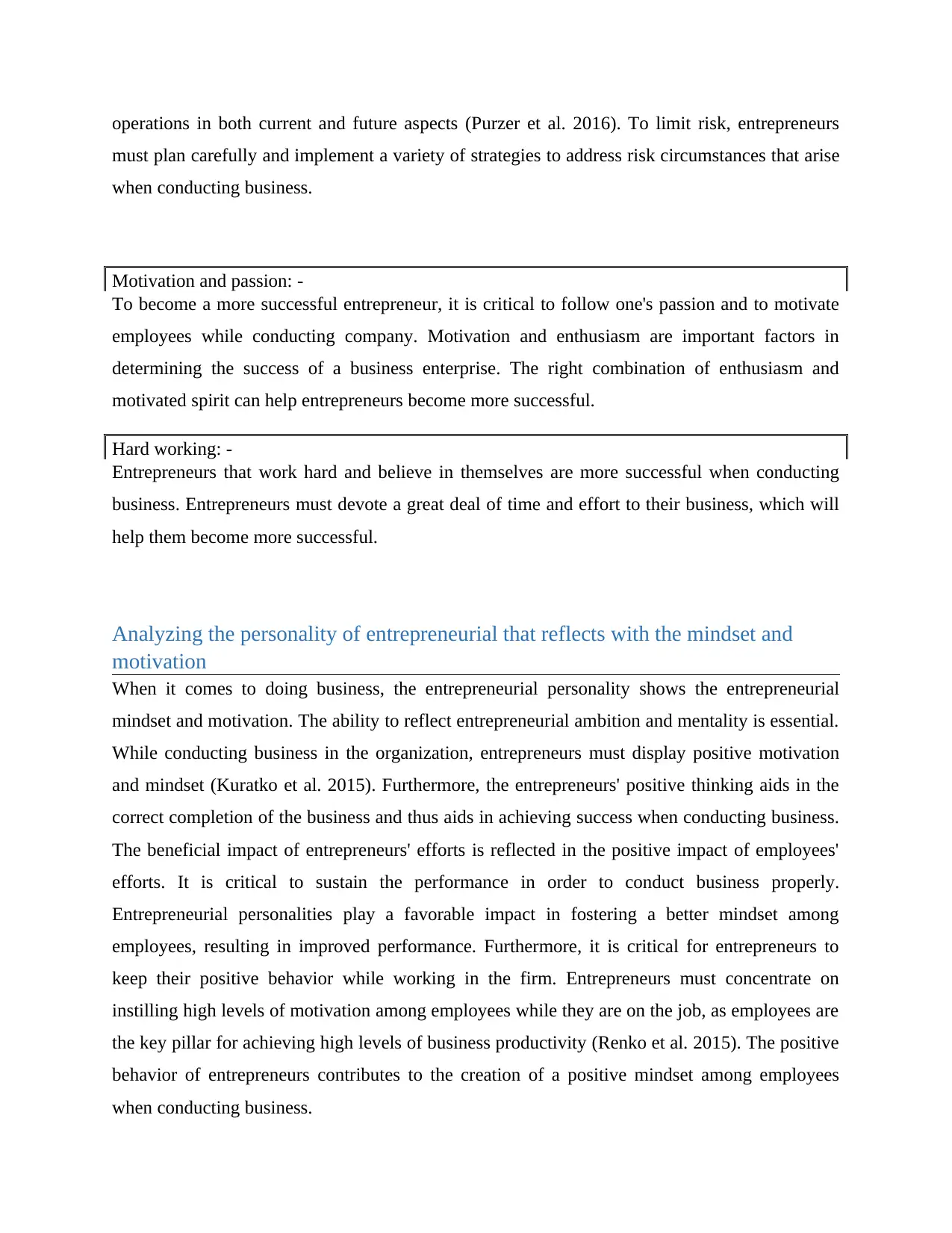
operations in both current and future aspects (Purzer et al. 2016). To limit risk, entrepreneurs
must plan carefully and implement a variety of strategies to address risk circumstances that arise
when conducting business.
Motivation and passion: -
To become a more successful entrepreneur, it is critical to follow one's passion and to motivate
employees while conducting company. Motivation and enthusiasm are important factors in
determining the success of a business enterprise. The right combination of enthusiasm and
motivated spirit can help entrepreneurs become more successful.
Hard working: -
Entrepreneurs that work hard and believe in themselves are more successful when conducting
business. Entrepreneurs must devote a great deal of time and effort to their business, which will
help them become more successful.
Analyzing the personality of entrepreneurial that reflects with the mindset and
motivation
When it comes to doing business, the entrepreneurial personality shows the entrepreneurial
mindset and motivation. The ability to reflect entrepreneurial ambition and mentality is essential.
While conducting business in the organization, entrepreneurs must display positive motivation
and mindset (Kuratko et al. 2015). Furthermore, the entrepreneurs' positive thinking aids in the
correct completion of the business and thus aids in achieving success when conducting business.
The beneficial impact of entrepreneurs' efforts is reflected in the positive impact of employees'
efforts. It is critical to sustain the performance in order to conduct business properly.
Entrepreneurial personalities play a favorable impact in fostering a better mindset among
employees, resulting in improved performance. Furthermore, it is critical for entrepreneurs to
keep their positive behavior while working in the firm. Entrepreneurs must concentrate on
instilling high levels of motivation among employees while they are on the job, as employees are
the key pillar for achieving high levels of business productivity (Renko et al. 2015). The positive
behavior of entrepreneurs contributes to the creation of a positive mindset among employees
when conducting business.
must plan carefully and implement a variety of strategies to address risk circumstances that arise
when conducting business.
Motivation and passion: -
To become a more successful entrepreneur, it is critical to follow one's passion and to motivate
employees while conducting company. Motivation and enthusiasm are important factors in
determining the success of a business enterprise. The right combination of enthusiasm and
motivated spirit can help entrepreneurs become more successful.
Hard working: -
Entrepreneurs that work hard and believe in themselves are more successful when conducting
business. Entrepreneurs must devote a great deal of time and effort to their business, which will
help them become more successful.
Analyzing the personality of entrepreneurial that reflects with the mindset and
motivation
When it comes to doing business, the entrepreneurial personality shows the entrepreneurial
mindset and motivation. The ability to reflect entrepreneurial ambition and mentality is essential.
While conducting business in the organization, entrepreneurs must display positive motivation
and mindset (Kuratko et al. 2015). Furthermore, the entrepreneurs' positive thinking aids in the
correct completion of the business and thus aids in achieving success when conducting business.
The beneficial impact of entrepreneurs' efforts is reflected in the positive impact of employees'
efforts. It is critical to sustain the performance in order to conduct business properly.
Entrepreneurial personalities play a favorable impact in fostering a better mindset among
employees, resulting in improved performance. Furthermore, it is critical for entrepreneurs to
keep their positive behavior while working in the firm. Entrepreneurs must concentrate on
instilling high levels of motivation among employees while they are on the job, as employees are
the key pillar for achieving high levels of business productivity (Renko et al. 2015). The positive
behavior of entrepreneurs contributes to the creation of a positive mindset among employees
when conducting business.
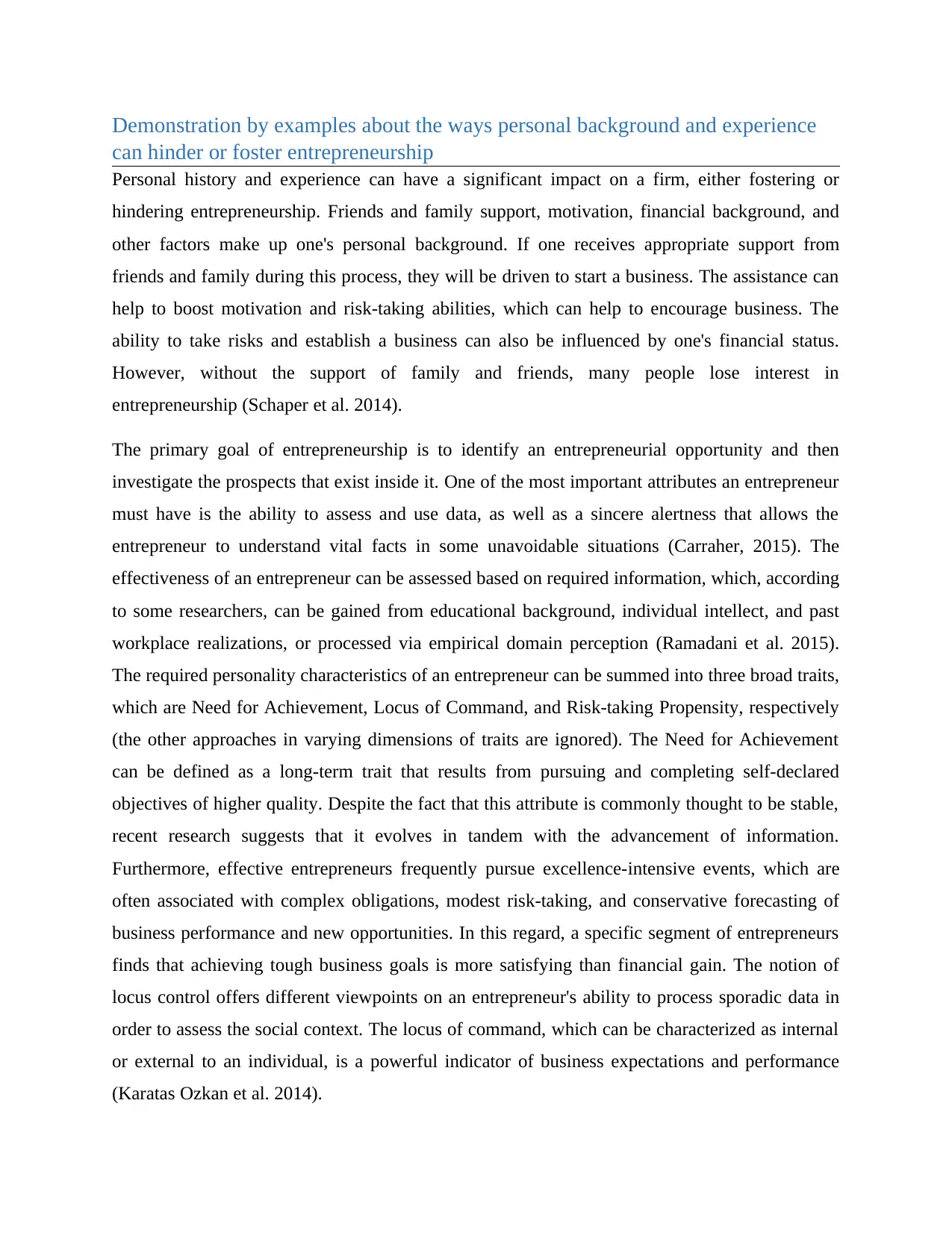
Demonstration by examples about the ways personal background and experience
can hinder or foster entrepreneurship
Personal history and experience can have a significant impact on a firm, either fostering or
hindering entrepreneurship. Friends and family support, motivation, financial background, and
other factors make up one's personal background. If one receives appropriate support from
friends and family during this process, they will be driven to start a business. The assistance can
help to boost motivation and risk-taking abilities, which can help to encourage business. The
ability to take risks and establish a business can also be influenced by one's financial status.
However, without the support of family and friends, many people lose interest in
entrepreneurship (Schaper et al. 2014).
The primary goal of entrepreneurship is to identify an entrepreneurial opportunity and then
investigate the prospects that exist inside it. One of the most important attributes an entrepreneur
must have is the ability to assess and use data, as well as a sincere alertness that allows the
entrepreneur to understand vital facts in some unavoidable situations (Carraher, 2015). The
effectiveness of an entrepreneur can be assessed based on required information, which, according
to some researchers, can be gained from educational background, individual intellect, and past
workplace realizations, or processed via empirical domain perception (Ramadani et al. 2015).
The required personality characteristics of an entrepreneur can be summed into three broad traits,
which are Need for Achievement, Locus of Command, and Risk-taking Propensity, respectively
(the other approaches in varying dimensions of traits are ignored). The Need for Achievement
can be defined as a long-term trait that results from pursuing and completing self-declared
objectives of higher quality. Despite the fact that this attribute is commonly thought to be stable,
recent research suggests that it evolves in tandem with the advancement of information.
Furthermore, effective entrepreneurs frequently pursue excellence-intensive events, which are
often associated with complex obligations, modest risk-taking, and conservative forecasting of
business performance and new opportunities. In this regard, a specific segment of entrepreneurs
finds that achieving tough business goals is more satisfying than financial gain. The notion of
locus control offers different viewpoints on an entrepreneur's ability to process sporadic data in
order to assess the social context. The locus of command, which can be characterized as internal
or external to an individual, is a powerful indicator of business expectations and performance
(Karatas Ozkan et al. 2014).
can hinder or foster entrepreneurship
Personal history and experience can have a significant impact on a firm, either fostering or
hindering entrepreneurship. Friends and family support, motivation, financial background, and
other factors make up one's personal background. If one receives appropriate support from
friends and family during this process, they will be driven to start a business. The assistance can
help to boost motivation and risk-taking abilities, which can help to encourage business. The
ability to take risks and establish a business can also be influenced by one's financial status.
However, without the support of family and friends, many people lose interest in
entrepreneurship (Schaper et al. 2014).
The primary goal of entrepreneurship is to identify an entrepreneurial opportunity and then
investigate the prospects that exist inside it. One of the most important attributes an entrepreneur
must have is the ability to assess and use data, as well as a sincere alertness that allows the
entrepreneur to understand vital facts in some unavoidable situations (Carraher, 2015). The
effectiveness of an entrepreneur can be assessed based on required information, which, according
to some researchers, can be gained from educational background, individual intellect, and past
workplace realizations, or processed via empirical domain perception (Ramadani et al. 2015).
The required personality characteristics of an entrepreneur can be summed into three broad traits,
which are Need for Achievement, Locus of Command, and Risk-taking Propensity, respectively
(the other approaches in varying dimensions of traits are ignored). The Need for Achievement
can be defined as a long-term trait that results from pursuing and completing self-declared
objectives of higher quality. Despite the fact that this attribute is commonly thought to be stable,
recent research suggests that it evolves in tandem with the advancement of information.
Furthermore, effective entrepreneurs frequently pursue excellence-intensive events, which are
often associated with complex obligations, modest risk-taking, and conservative forecasting of
business performance and new opportunities. In this regard, a specific segment of entrepreneurs
finds that achieving tough business goals is more satisfying than financial gain. The notion of
locus control offers different viewpoints on an entrepreneur's ability to process sporadic data in
order to assess the social context. The locus of command, which can be characterized as internal
or external to an individual, is a powerful indicator of business expectations and performance
(Karatas Ozkan et al. 2014).
⊘ This is a preview!⊘
Do you want full access?
Subscribe today to unlock all pages.

Trusted by 1+ million students worldwide
1 out of 14
Related Documents
Your All-in-One AI-Powered Toolkit for Academic Success.
+13062052269
info@desklib.com
Available 24*7 on WhatsApp / Email
![[object Object]](/_next/static/media/star-bottom.7253800d.svg)
Unlock your academic potential
Copyright © 2020–2025 A2Z Services. All Rights Reserved. Developed and managed by ZUCOL.





